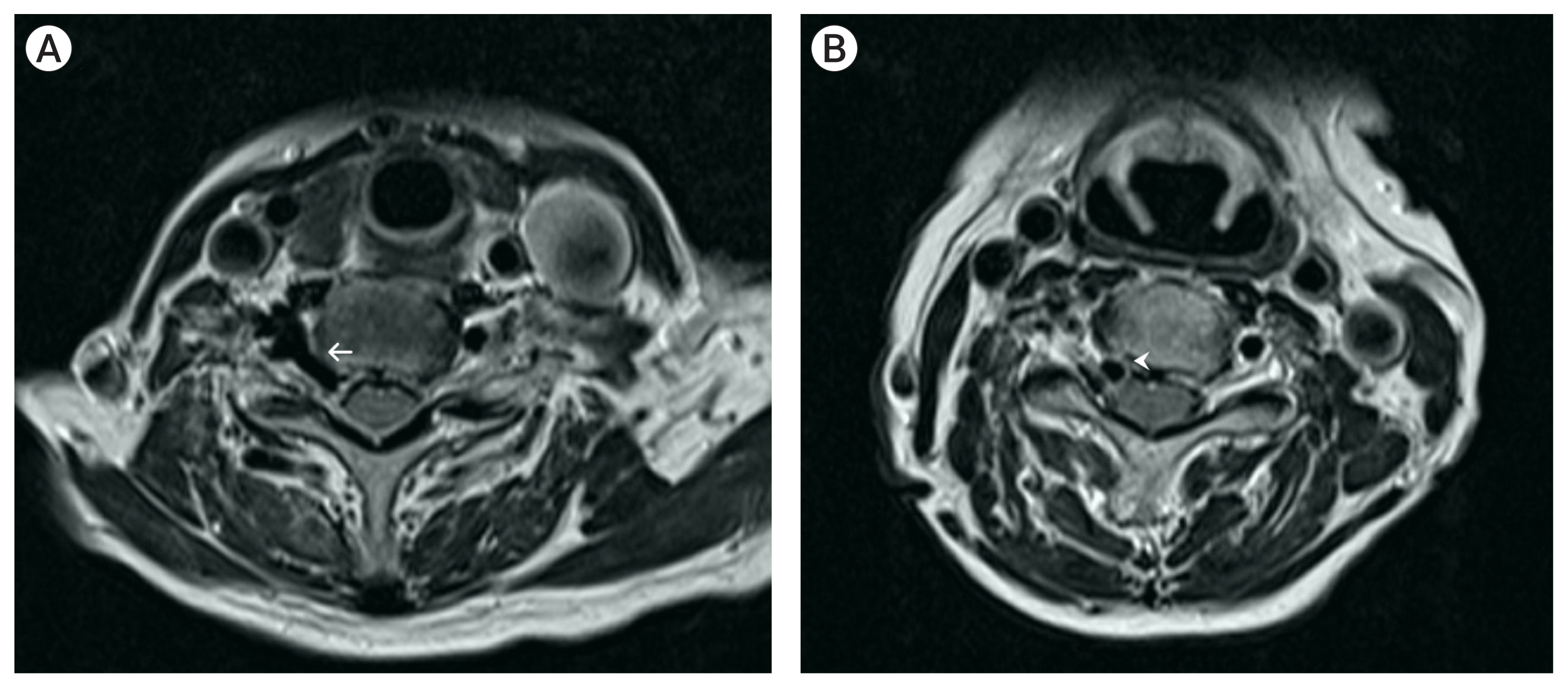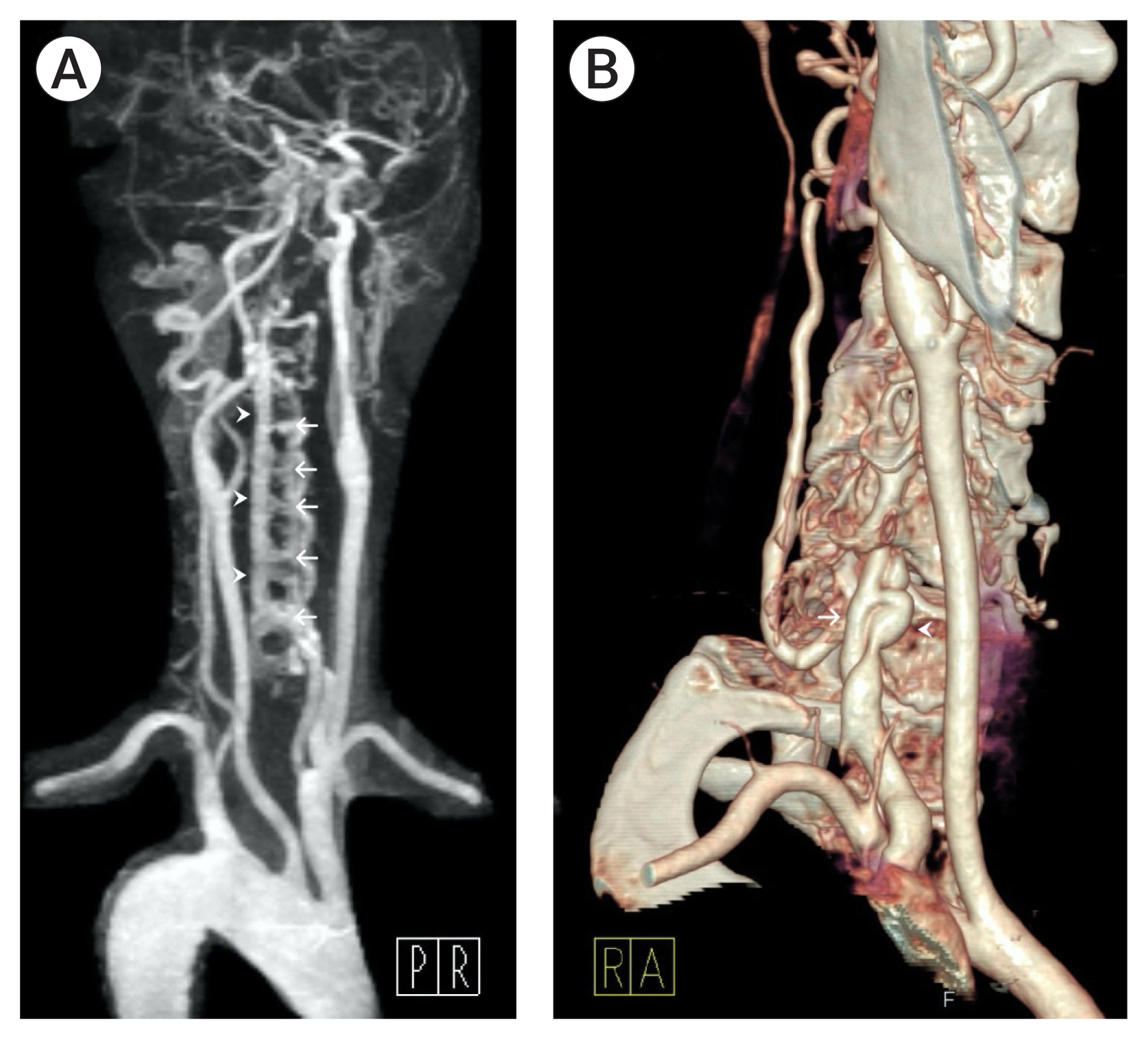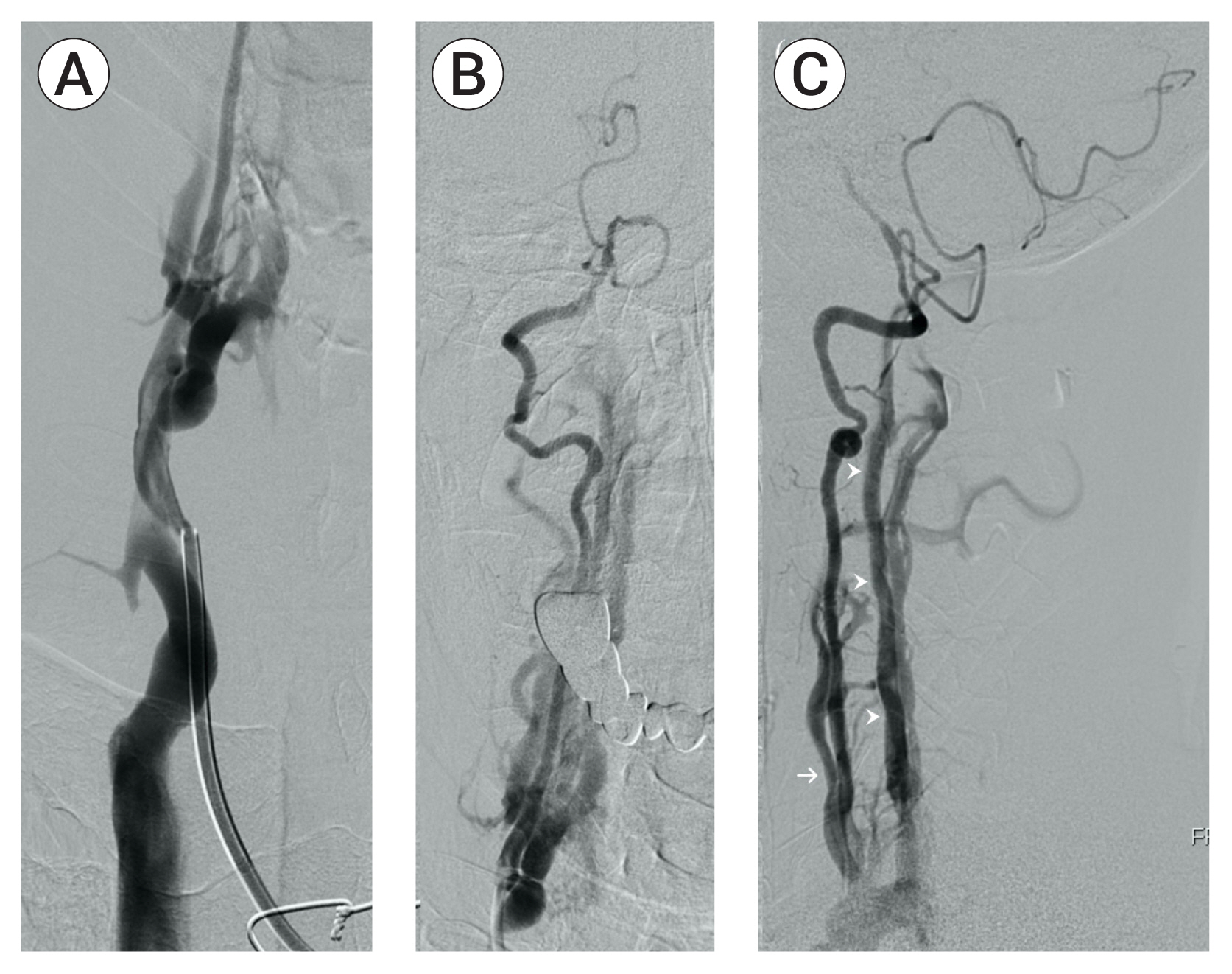J Cerebrovasc Endovasc Neurosurg.
2020 Sep;22(3):182-189. 10.7461/jcen.2020.22.3.182.
Cervical spinal extradural arteriovenous fistula successfully treated using transarterial balloon-assisted coil embolization
- Affiliations
-
- 1Department of Neurosurgery, Dongsan Medical Center, Keimyung University School of Medicine, Daegu, Korea
- KMID: 2506765
- DOI: http://doi.org/10.7461/jcen.2020.22.3.182
Abstract
- We present the case of a patient who developed compressive radiculopathy that was found to be associated with a spinal extradural arteriovenous fistula. The fistula was successfully obliterated with transarteiral balloon-assisted coiling, after which the patient was symptom-free. Although spinal extradural arteriovenous fistula is rare, this pathology should be considered in the differential diagnosis of spinal radiculopathy or myelopathy. Endovascular treatment appears to have been successful in resolving the symptoms associated with this pathology.
Keyword
Figure
Reference
-
1. Aljobeh A, Sorenson TJ, Bortolotti C, Cloft H, Lanzino G. Vertebral arteriovenous fistula: a review article. World Neurosurg. 2019; Feb. 122:e1388–97.
Article2. Ashour R, Orbach DB. Lower vertebral-epidural spinal arteriovenous fistulas: a unique subtype of vertebrovertebral arteriovenous fistula, treatable with coil and Penumbra Occlusion Device embolization. J Neurointerv Surg. 2016; Jun. 8(6):643–7.
Article3. Briganti F, Tedeschi E, Leone G, Marseglia M, Cicala D, Giamundo M, et al. Endovascular treatment of vertebro-vertebral arteriovenous fistula. A report of three cases and literature review. Neuroradiol J. 2013; Jun. 26(3):339–46.4. Briganti F, Tortora F, Elefante A, Volpe A, Bruno MC, Panagiotopoulos K. An unusual case of vertebral arteriovenous fistula treated with electrodetachable coil embolization. Minim Invasive Neurosurg. 2004; Dec. 47(6):386–8.
Article5. Brinjikji W, Colombo E, Lanzino G. Clinical and angioarchitectural characteristics of spinal vascular malformations of the cervical spine. J Neurosurg Spine. 2020; Jan. 1–8.
Article6. Brinjikji W, Yin R, Nasr DM, Lanzino G. Spinal epidural arteriovenous fistulas. J Neurointerv Surg. 2016; Dec. 8(12):1305–10.
Article7. Geng J, Hu P, Ma Y, Zhang P, Zhang H. Endovascular treatment of V3 segment vertebro-vertebral arteriovenous fistula with Willis covered stent: Case report and literature review. Interv Neuroradiol. 2019; Feb. 25(1):97–101.
Article8. Guneyli S, Cinar C, Bozkaya H, Korkmaz M, Oran I. Endovascular management of congenital arteriovenous fistulae in the neck. Diagn Interv Imaging. 2016; Sep. 97(9):871–5.
Article9. Hiramatsu M, Sugiu K, Ishiguro T, Kiyosue H, Sato K, Takai K, et al. Angioarchitecture of arteriovenous fistulas at the craniocervical junction: a multicenter cohort study of 54 patients. J Neurosurg. 2018; Jun. 128(6):1839–49.
Article10. Honarmand AR, Ansari SA, Alden TD, Soltanolkotabi M, Schoeneman SE, Hurley MC, et al. Endovascular management of pediatric high-flow vertebro-vertebral fistula with reversed basilar artery flow. A case report and review of the literature. Interv Neuroradiol. 2013; Jun. 19(2):215–21.11. Huang W, Gross BA, Du R. Spinal extradural arteriovenous fistulas: clinical article. J Neurosurg Spine. 2013; Nov. 19(5):582–90.12. Hughes DG, Alleyne CH Jr. Rare giant traumatic cervical arteriovenous fistula in neurofibromatosis type 1 patient. BMJ Case Rep. 2012; Jun. 2012:bcr1220115354.
Article13. Inoue T, Endo T, Sato K, Fesli R, Ogawa Y, Fujimura M, et al. Massive intramedullary hemorrhage after subarachnoid hemorrhage in patient with vertebrovertebral arteriovenous fistula. World Neurosurg. 2019; Sep. 129:432–6.
Article14. Kawabori M, Hida K, Yano S, Asano T, Iwasaki Y. Cervical epidural arteriovenous fistula with radiculopathy mimicking cervical spondylosis. Neurol Med Chir (Tokyo). 2009; Mar. 49(3):108–13.
Article15. Li F, Song X, Liu C, Liu B, Zheng Y. Endovascular stent-graft treatment for a traumatic vertebrovertebral arteriovenous fistula with pseudoaneurysm. Ann Vasc Surg. 2014; Feb. 28(2):489.e11–4.
Article16. Miralbes S, Cattin F, Andrea I, Bonneville JF. Vertebral arteriovenous fistula: endovascular treatment with electrodetachable coils. Neuroradiology. 1998; Nov. 40(11):761–2.
Article17. Miyamoto N, Naito I, Takatama S, Iwai T, Tomizawa S, Inoue HK. Spinal epidural arteriovenous fistulas with unusual manifestation of sudden onset of severe neurological deficits: case report. Neurol Med Chir (Tokyo). 2013; 53(12):896–901.
Article18. Nakagawa I, Park HS, Hironaka Y, Wada T, Kichikawa K, Nakase H. Cervical spinal epidural arteriovenous fistula with coexisting spinal anterior spinal artery aneurysm presenting as subarachnoid hemorrhage--case report. J Stroke Cerebrovasc Dis. 2014; Nov–Dec. 23(10):e461–5.
Article19. Ono I, Satow T, Ito Y, Hamano E, Matsubara H, Kataoka H, et al. Case of iatrogenic vertebro-vertebral arteriovenous fistula treated by combination of double-catheter and balloon anchoring techniques. World Neurosurg. 2019; Aug. 128:98–101.
Article20. Rajadurai S, Muthukumaraswamy S, Hussain Z. Endovascular treatment of vertebral-venous fistula with flow-diverting stent. World Neurosurg. 2019; Jan. 121:33–6.
Article21. Rangel-Castilla L, Holman PJ, Krishna C, Trask TW, Klucznik RP, Diaz OM. Spinal extradural arteriovenous fistulas: a clinical and radiological description of different types and their novel treatment with Onyx. J Neurosurg Spine. 2011; Nov. 15(5):541–9.
Article22. Shirakawa M, Nishioka T, Yamashita K, Maeda Y, Arita N. Traumatic vertebro-vertebral arteriovenous fistula manifesting as radiculopathy. Case report. Neurol Med Chir (Tokyo). 2008; Apr. 48(4):167–70.23. Takai K, Shojima M, Imai H, Saito N, Taniguchi M. Microsurgical and endovascular treatments of spinal extradural arteriovenous fistulas with or without intradural venous drainage. World Neurosurg. 2018; Mar. 111:e819–29.
Article24. Takai K, Taniguchi M. Comparative analysis of spinal extradural arteriovenous fistulas with or without intradural venous drainage: a systematic literature review. Neurosurg Focus. 2012; May. 32(5):E8.
Article25. Tenjin H, Kimura S, Sugawa N. Coil embolization of vertebro-vertebral arteriovenous fistula: a case report. Surg Neurol. 2005; Jan. 63(1):80–3. discussion 83.
Article26. Walcott BP, Berkhemer OA, Leslie-Mazwi TM, Chandra RV, Ogilvy CS, Yoo AJ. Multimodal endovascular treatment of a vertebrovertebral fistula presenting with subarachnoid hemorrhage and hydrocephalus. J Clin Neurosci. 2013; Sep. 20(9):1295–8.
Article27. Wang Q, Song D, Chen G. Endovascular treatment of high-flow cervical direct vertebro-vertebral arteriovenous fistula with detachable coils and Onyx liquid embolic agent. Acta Neurochir (Wien). 2011; Feb. 153(2):347–52.
Article28. Yeh CH, Chen YL, Wu YM, Huang YC, Wong HF. Anatomically based approach for endovascular treatment of vertebro-vertebral arteriovenous fistula. Interv Neuroradiol. 2014; Dec. 20(6):766–73.
Article
- Full Text Links
- Actions
-
Cited
- CITED
-
- Close
- Share
- Similar articles
-
- Persistent Trigeminal Artery with a Cerebellar Branch and Trigeminal-Cavernous Fistula from Ruptured Aneurysm: Transarterial Coil Embolization
- A Case of Percutaneous Transcatheter Coil Embolization for Congenital Coronary Arteriovenous Fistula
- Spinal Epidural Arteriovenous Fistula Presented with Subdural Hematoma: a Case of Transarterial Embolization Using NBCA
- Vein of Galen Aneurysmal Malformation: Treatment by Transarterial Venous Sac and Fistula Embolization Using Coils and Glue
- A Case of Giant Aneurysm of Coronary Arteriovenous Fistula Treated by Percutaneous Deployment of Embolization Coil






